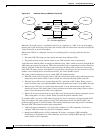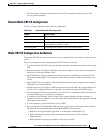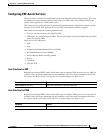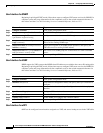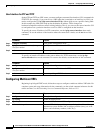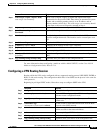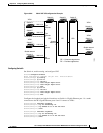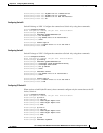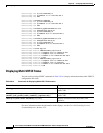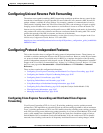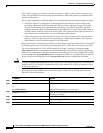
38-79
Cisco Catalyst Switch Module 3110 and 3012 for IBM BladeCenter Software Configuration Guide
OL-12189-01
Chapter 38 Configuring IP Unicast Routing
Configuring Multi-VRF CE
For more information about configuring a multicast within a Multi-VRF CE, see the Cisco IOS IP
Multicast Configuration Guide, Release 12.4.
Configuring a VPN Routing Session
Routing within the VPN can be configured with any supported routing protocol (RIP, OSPF, EIGRP, or
BGP) or with static routing. The configuration shown here is for OSPF, but the process is the same for
other protocols.
Beginning in privileged EXEC mode, follow these steps to configure OSPF in the VPN:
Step 5
route-target {export | import | both}
route-target-ext-community
Create a list of import, export, or import and export route target
communities for the specified VRF. Enter either an autonomous-system
number and an arbitrary number (nnn:y) or an IP address and an
arbitrary number (A.B.C.D:y). The route-target-ext-community should
be the same as the route-distinguisher entered in Step 4.
Step 6
import map route-map (Optional) Associate a route map with the VRF.
Step 7
ip multicast-routing vrf vrf-name
distributed
(Optional) Enable global multicast routing for VRF table.
Step 8
interface interface-id Specify the Layer 3 interface to be associated with the VRF, and enter
interface configuration mode. The interface can be a routed port or an
SVI.
Step 9
ip vrf forwarding vrf-name Associate the VRF with the Layer 3 interface.
Step 10
ip address ip-address mask Configure the IP address for the Layer 3 interface.
Step 11
ip pim sparse-dense mode Enable PIM on the VRF-associated Layer 3 interface.
Step 12
end Return to privileged EXEC mode.
Step 13
show ip vrf [brief | detail | interfaces]
[vrf-name]
Verify the configuration. Display information about the configured
VRFs.
Step 14
copy running-config startup-config (Optional) Save your entries in the configuration file.
Command Purpose
Command Purpose
Step 1
configure terminal Enter global configuration mode.
Step 2
router ospf process-id vrf vrf-name Enable OSPF routing, specify a VPN forwarding table,
and enter router configuration mode.
Step 3
log-adjacency-changes (Optional) Log changes in the adjacency state. This is the
default state.
Step 4
redistribute bgp
autonomous-system-number subnets
Set the switch to redistribute information from the BGP
network to the OSPF network.
Step 5
network network-number area area-id Define a network address and mask on which OSPF runs
and the area ID for that network address.
Step 6
end Return to privileged EXEC mode.
Step 7
show ip ospf process-id Verify the configuration of the OSPF network.
Step 8
copy running-config startup-config (Optional) Save your entries in the configuration file.




